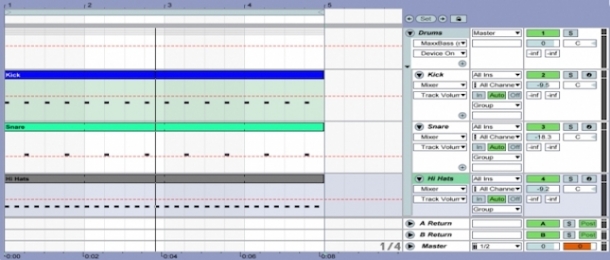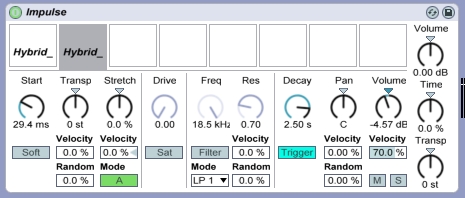
If you're reading this article, you probably already know how to program a basic beat in a DAW but perhaps there's still something not quite right'somehow your pattern just doesn't really inspire you to move, or there's still a little something missing and you can't quite put your finger on it - I'm sorry to be the one to break this to you, but your beat has no groove!
What exactly is 'groove'' I hear you ask - well, it's a tricky thing to define. The word 'groove' in this context could also be replaced with 'feel' and what it really represents is a certain human-like essence in the rhythm that inspires your head to nod or your feet to move. This makes the term sound somewhat ethereal, however I think it can actually be boiled down to two main elements in the sound: dynamics and timing (both deliberate and accidental).
This is a topic that we've already touched upon in a previous article, creating natural hi hat patterns, and the same principles apply here - we'll consider how a real-life drummer would manipulate the sound and try our best to replicate this in the electronic domain. Ultimately it is this 'natural' or 'humanistic' approach that will bring our beats the feel and groove we need to get bodies moving out there in the real world!
Delicious Dynamics
First of all, let's look at how we can use dynamics to give some groove to our beats. I'll just briefly mention that I'm going to be using Ableton Live in my demonstration of the following ideas but you can of course apply these tips to any DAW you like. I'll also be using samples from our Hybrid Drums - Live & Electronic Drum Samples release.
Here we have a straight 4 to the floor beat, with snare and claps on the backbeat, and 8th note hi hats:
The resulting sound is quite jarring and mechanical - the hi hats are clearly too loud overall, and the snare/claps don't really have any impact. Let's fix the volumes between the parts of the kit first of all:

Now we have a more balanced overall sound - we've brought the snare out a lot more to accentuate the backbeat, and pushed the hi hats lower in the mix, as their primary purpose in this case is to add a bit of texture. Sticking with the hi hats, let's play with the inner dynamics of this part of the kit. Since we have a straight 8th-note pattern, we'll now apply what's called the 'push-pull' technique - where the downbeats are accentuated and the offbeats are played lighter on the stick upstroke. Here's a brief video explaining the idea in greater detail:
This technique is commonly used by drummers as it effectively means 2 hits can be made with 1 downstroke of the arm - it's an energy saver! Let's apply it to the hi hats in our beat by adjusting velocity:

Things are starting to groove a bit more now, however there's one thing to pay attention too - since we're adding more velocity to the downbeat, and also using the shoulder of the stick (so to speak), the timbre of the sound should vary slightly from the softer upbeat stroke which uses the tip of the stick in the case of real drumming. Let's move the offbeat to another drum channel, and adjust the sample start time and volume to reflect this lighter sound:


Now let's carry this same idea on to the snare drum. When we add lighter hits to this particular drum, they tend to be referred to as 'ghost notes', and this gives a big clue as to how prominent they should be in terms of dynamics. Now might be a good time to go on a bit of a Youtube binge and study how drummers use this technique - you'll find that that these hits tend to fall on the 16th-notes in between the 8ths on the hi hat. Let's add some extra snare hits in without applying dynamics first:

The whole feel of the beat has changed now. There's nothing wrong with this per se, however in our case we want to keep the accents on the 4 beats of the bar, and use the extra snare hits to add some human-like texture. Again, let's play with the sample start time and levels of these extra snare hits to get the right feel for these ghost notes:
Our beat is starting to take shape now! However there's still a problem with the dynamics - they're too perfect. No real player is ever going to hit the drums exactly the same way each time, so we need to introduce a bit of human error into the fold to make it more natural sounding. Let's add some slight variation in velocity to our hats and snare:

Tasty Timing
This brings us nicely onto the timing aspect - no drummer is ever going to play exactly on time, although some will come very close'we want to reflect this in our beat, so let's shift some of our hits off the grid very slightly. Be careful not to shift them too far or we'll end up just sounding like a bad drummer!

Taking this one step further, we may add some deliberate timing techniques to give our beat a little swing. We need to shift our 16th notes a bit further off the grid, to the point where our beat has a bit of 'bounce'. You'll need to use a bit of trial and error here as this can be a little tricky to replicate. Some DAWs actually have a 'swing' function that will do this automatically for you, however if you want a truly unique feel then we'd suggest doing it yourself:

And there we have it, our beat now has some real groove! Follow the above steps and you'll be humanising your rhythm section in no time.
We've been very surgical in our approach here, and there's nothing wrong with that, but it can be very time-consuming. Ideally, you don't want to be bogged down in making minor adjustments all the time, as you may lose sense of the bigger picture when producing - particularly when you're in the middle of the creative flow. Here are some further suggestions to help you move forward with this idea:
- Put some dedicated time aside just for working on this technique - you could create your own 'pre-grooved' loops/samples that are ready to drop into any track you have going.
- Think about playing your beats in live with a MIDI controller - this will capture all the imperfections immediately, and you can easily make any adjustments to noticeably duff notes afterwards. This will also help to give you a sense of what is physically possible for a drummer - some sounds cannot be played at the same time (e.g open hat and closed hat), and this will add to the 'human' feel.
- Some synths will also help you along the way, triggering different samples based on velocity which will produce the different timbres we talked about earlier.
- Look for a MIDI 'humanising' algorithm that will automatically apply these principles to your beat.













